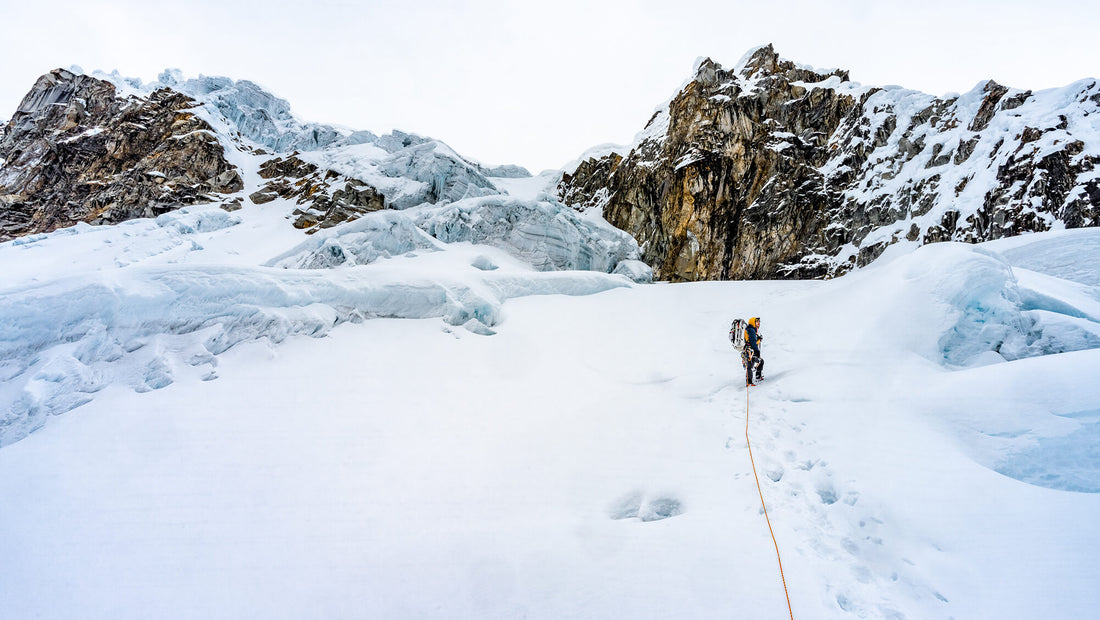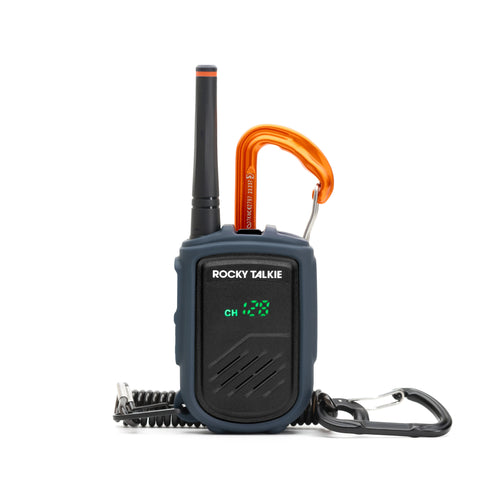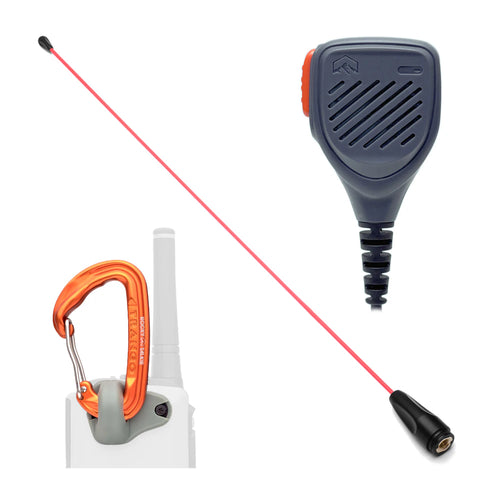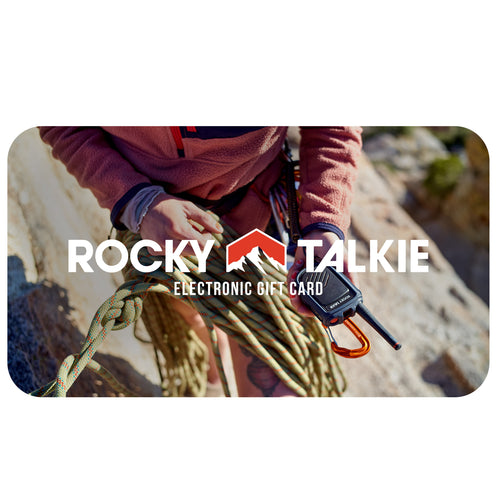
Rock Climbing Communication - A Primer on How To Stay Safe
| 12 min read | 3 CommentsAs a former editor at both Rock and Ice and Climbing magazines, I’ve written about a lot of accidents. Some minor, some major. Some on rock, some on ice, some deep in the mountains. Thinking back on all of them, one of the dominant themes that pops up time and time again is a breakdown in communication.
This can take any number of forms. It can be as simple as not talking about the specifics of either lowering off of or rappelling off of a single-pitch sport climb. Or in crowded areas, partners have confused stray yells from other parties as those of their own partner. In still other scenarios rope-tug commands have been misunderstood on multi-pitch climbs. And then, of course, in high winds, on alpine climbs, it can be hard to hear your partner or anyone else yell anything at all—making recovering from a small misstep catastrophic.
I spent this past July climbing down in the Cordillera Blanca in Peru. My partner Levi Harrell and I climbed in a variety of styles, including single-pitch sport climbing on the rock forest of Hatun Machay, and full-on alpine climbing on ice and mixed terrain at nearly 20,000 feet on Alpamayo. And then there were long trekking approaches, and complex photo shoots of our climbing. The differences in these disciplines and activities are stark; but the ability to talk to my partner was important for all of them.
With a single, small tool—a walkie talkie—nearly all of the communication problems I’ve read and written about as a journalist, and many more, can be prevented. Peru highlighted that for me: high up on a snowy face with the wind howling, screaming into the void is a fool’s errand. Yet even with that walkie talkie, the importance of observing best practices in communicating with one’s partner remains paramount. The following is a quick-and-dirty overview to climbing communication—for both single pitch and multipitch—and how to avoid some of the most common miscommunication pitfalls.
Single Pitch Climbing: Lowering Off or Rappelling?

The simplicity of single-pitch climbing can lure us into a false sense of security. I can see and hear my partner, what could go wrong? But this complacency is one of the most dangerous forces in climbing: Most accidents you read about in the magazines or the AAC’s Accidents in North American Climbing are the result not of gear malfunction, but of human error.
As Francis Sanzaro, a former colleague at Rock and Ice, wrote in an accident report, “Complacency can cause accidents when you let your guard down, even for a second. This goes for rote tasks such as rappelling and belaying as well: Climbers continue to be killed and injured in avoidable rappelling and belaying accidents. Be vigilant in all scenarios, especially the ones we often take for granted.”
So how can one avoid the complacency trap? When you’re out cragging, it certainly is a lower-key affair than a big alpine day, but there are a few small things that—if you do them every time—will vastly improve your chances of going home safe.
Make a plan before you leave the ground.
This ain’t rocket science. Before starting up the climb, confirm with your belayer what you guys are doing, i.e. lowering or rappelling. Make this step as fundamental a part of your pre-climbing routine as tying your knot (stay vigilant about that, too!), and it’ll become second nature.The hardware my partner Levi and I encountered in Hatun Machay, Peru, was mostly quite good. Many of the climbs had rings or chainlinks at the top, so we decided we would plan to lower off climbs when possible.
Never assume!
This is a fail-safe protocol for the “make a plan step.” Just because you’ve made a plan or use the same plan every time, doesn’t mean there aren’t times people forget things or make honest mistakes. Never assume your belayer is doing something: get verbal or visual confirmation. Do they still have you on belay? Have they taken you off belay? In addition to checking with your belayer, after cleaning a set of anchors, always always always remain in-direct until you can confirm that your partner is lowering you or you are rappelling. Taking a few extra seconds to be sure is always worth it.To be Extra Safe? Bring a radio!
I’ll be honest here. I have no intention of bringing a walkie talkie up a single pitch climb—trad or sport—on my own person in the near future. I’ve been climbing all styles for a decade, have systems and precautions that have served me well thus far, and only climb with partners I trust fully. For most experienced climbers, radios are unnecessary on single pitch climbs.That being said, there are scenarios where the plan changes and the ability to communicate said change easily is reassuring. Consider the following: One afternoon at Hatun Machay, I led a lovely 5.11a and planned to have my partner lower me from the rings at the top. However, when I got to the anchor, I saw that—unlike the nice hardware on the other pitches we had already done over the past two days—this anchor was simply a length of webbing tied into two bolt hangers. Lowering off something like this is a massive no-no: the friction of the rope on the webbing can melt the latter. Not a big deal: I’d just tell my partner that I was going to rappel. But even though I was only 90 feet away from him, yelling back and forth was tough. The winds swallowed our words. Eventually we got on the same page—but a radio would have made it easier!
So: For the newbie climber in particular, radios even on single-pitch climbs aren’t a bad idea. They provide one extra channel of crystal-clear communication. Did you forget what the plan you guys decided on was? Just radio down.
Other climbers might feel the need to weirdly flex if they see you use a radio at the crag as you clean a 5.7. But pay no mind: the climber who is safe is the right one.

Multipitch Madness: Commands and More
The systems and the number of things you need to remember when you commit to a multipitch climb multiply considerably. The elements become a greater factor. Making sure you have everything you need becomes a factor. Knowing how to bail. Knowing where the route goes. The complexity increases, and with that comes more risk.
There are several methods for multipitch belay commands. Here we consider each and their benefits and drawbacks.
Vocal Commands.
If you and your partner can hear one another, hollering back and forth even on a multipitch route is the simplest option. In a quiet, calm area, vocal commands work fine. But if not, problems can compound quickly.Let’s say you lead the third pitch of a route and build an anchor when you’ve got no rope left. You yell down to let your partner know that you’re safe and start going about your business of setting up the belay. But what if he can’t hear you? Maybe it’s too windy or he’s too far away. What if he can hear you just slightly, and mishears your words? The elements can modulate our voices in strange ways and play tricks on our auditory faculties. It’s not a stretch to imagine someone mishearing “I’m at the belay” as “You’re on belay.” It’s a frightening thought.

While climbing Alpamayo—a 19,511-foot pyramid of ice in the Cordillera Blanca that has been called the most beautiful mountain in the world—Levi and I had walkie talkies on us, but sometimes we would try to shout over the wind. While on the sharp end on one particular pitch, I was getting hammered by spindrift. I had my head down, death-gripping my tools so as not to be swept off the side of the face. Each time another wave of snow arrived, I yelled down to Levi to alert him about the incoming bombardment. Later, after I had reached the next belay and had brought him up, Levi said that he hadn’t been able to hear a word.
The issues with vocal commands on multipitch routes are even greater in crowded areas. If you’re in a popular spot—think the Gunks, in New York, or Eldorado Canyon, in Colorado—other parties are frequently hooting and hollering to their own friends. It is all too easy to confuse the shouts of other parties as those of your partner.
For these reasons and more, vocal commands can be an okay starting point—but should never be the only option.
Rope Tugs.
The dominant alternative communication system to vocal commands on multipitch climbs these days—and one with which all climbers should be familiar—is rope tugs. In essence, commands are conveyed through different numbers of tugs on the rope, e.g. three tugs could mean, “You’re on belay.”Rope tugs generally work well. I’ve relied on them on rock routes and in the bigger mountains. Even if you intend to use vocal communication, it is highly advisable to have an agreed upon set of rope-tug commands with one’s partner. But still, rope tugs are no panacea in terms of multipitch communication.
One potential pitfall with rope tugs is that there is no universal standardized system. Some people use three tugs, some people use two; some people give a first set of tugs to mean, “I’m safe!” and a second set to mean, “On belay,” while other people just give a single set that communicates both.
Another drawback, particularly for less experienced climbers, is the know-how required to discern the difference between intentional tugs and any other pulling (whether to take up slack, adjust something before someone is actually on belay, etc.).
When I first learned about rope tugs, I didn’t fully appreciate what a “tug” was supposed to be. I’d get up to a belay and pull on the rope, let it go, pull on the rope, let it go, thinking that was good enough. It wasn’t until I had a partner that yanked the rope for his tugs—sharp, unmistakable, violent jerks of the rope—that I understood: A rope tug should not have to be watched for; it should be unambiguously felt, and it should be 100% obvious to your follower what is happening. Anything less and you’re not tugging hard enough.
Still, other things can interfere with rope-tug communication. While climbing Alpamayo in Peru, pitches were rarely straight forward. One pitch might involve ducking in and out of penitentes and merengue-like snow mushrooms, dragging the rope over a protruding rock, and then transitioning between multiple ice runnels. On a 70-meter pitch like that, rope tugs are liable to get lost and dissipate as they travel from one end of the rope to the other.
Walkie Talkies.
For most of the ways that vocal commands and rope tugs can lead to problems, walkie talkies offer a way to convey clear and concise messages and commands to one’s partner on a multipitch.While climbing Alpamayo, my partner and I made ample use of our Rocky Talkies - a small radio company founded by climbers. Even beyond regular belay commands, we often radioed back and forth to check in on one another, to give updates on conditions in our respective locations (which, surprisingly, could be like night and day!).
(Note that walkie talkies should never be considered a replacement for knowing how to use rope tugs or vocal commands or any other communication system. Knowing how to communicate via non-verbal systems is critical and fundamental multipitch knowledge.)
 The communication snafus—or rather miscommunicaton snafus—that can be avoided on a multipitch climb if you bring walkie talkies are as many as you can dream up. Think about the things you’d like to tell your partner about right away: a dropped belay device, a storm coming in over the ridge, a stuck piece of gear you’re working to free. The scenarios are endless.
The communication snafus—or rather miscommunicaton snafus—that can be avoided on a multipitch climb if you bring walkie talkies are as many as you can dream up. Think about the things you’d like to tell your partner about right away: a dropped belay device, a storm coming in over the ridge, a stuck piece of gear you’re working to free. The scenarios are endless.
I can’t count the number of times I’ve gotten off route on some second-tier route and wished I could radio down to my belayer and ask, Where the hell do I go now? Or just let her know, Sorry, it’s taking so long, I’m figuring things out! With a walkie talkie you can do that.
There was one particularly exciting moment on Alpamayo where we were extremely thankful to have the Rocky Talkies. I was on the sharp end, out of sight and hearing distance of my partner. The narrow couloir I was in petered out—I needed to hop over to a different runnel to the right, I realized. But doing so involved traversing a section of rotten sun-baked ice and featureless rock slab, something I was not willing to do above my already marginal gear. I managed to get a solid ice screw, and radioed down to my partner to lower me a bit. I told him I was going to pendulum over to the good ice in the other runnel (gasp, aid climbing!). It all went off without a hitch.
Once I was climbing again on the good ice, I imagined what it would have been like trying to communicate that unplanned maneuver to my partner without the radios. Trying to yell my plan down? Horrific! Somehow using rope tugs? Impossible!
Communication Considerations For the More Advanced
The more experience you gain moving fast on big routes, be they made of rock or ice or snow, the more you realize the incomparable value of trusting your partner’s skills and decision-making. You can’t always see or hear what they’re doing, so knowing that you guys have similar philosophies, risk tolerances, and aptitude on whatever terrain you’re climbing is invaluable.
But even when all those things align, an added layer of communication in scenarios that—by their very nature—have more moving parts or variables, is an excellent idea. Two such scenarios are simul-climbing and new routing.

Simul-Climbing.
Simul-climbing is an advanced technique and requires a great deal of know-how in terms of the systems. Climbers should also be aware of the risks involved, as accidents can be of higher consequence than other methods of climbing. But we’re not here to go over the nuts and bolts of simul-climbing.The unique thing about simuling is that the gear equation is constantly changing: as the leader moves up, he is continually placing more pieces of protection; as the second climber simultaneously follows, he is removing pieces of protection. The key—obviously—is to ensure that there is always enough protection between the two climbers to prevent catastrophe should either fall.
Radios are a lifesaver—sometimes literally—in simul-climbing. When I was in Peru, I teamed up with a Polish climber for a new route on a peak called Jangyaraju. We pitched out the entire route save for one loooong pitch that we simuled. Protection on this pitch was sparse, consisting of pounded in pickets and the occasional ice screw, so it was vital to know how much gear was between us at all times as we inched upward; removing one piece might halve our protection at any given moment.
I was the second climber: each time I came to a piece, I’d radio up to my partner to let him know I was about to remove it. In this way we were able to verify that we always had enough pieces between us to feel safe. We never wanted to be in that situation of Brad Gobright yelling down to Jim Reynolds on their speed ascent of the Nose: toward the top of the route, which they were simuling, Gobright yelled down to Reynolds, “No gear, don’t fall!”
And with radios, we were able to make sure that was never the case.
New Routing.
The bodies in motion on a new routing adventure aren’t any more than on a regular outing, but the unknowns certainly are. Will there be loose rock? A dead end? Poorly protected runout climbing? Maybe you’ll need to place a bolt?On our new route on Jangyaraju, the final pitch was harrowing: My partner pounded pitons, and nested microcams in a minimally featured rock slab covered beneath several feet of sugary Andean snow, running it out 30 and 40 feet at a time. At one point he radioed down to me, “I could fall at any moment!” The Rocky Talkies made it feel like we had a better handle on the situation than we would have otherwise. We had planned for him to bring me up once he reached the summit ridge, but, unable to find any decent anchors, we opted to simul, something that he could communicate easily via the airwaves.
As beginner climbers, everyone learns the importance of redundancy: Always have a back up. Don’t trust you or your partner’s life to a single point of failure.
Why shouldn’t redundancy extend toward our methods of communication as well? Verbal commands, rope tugs, and radios all can—and all should—be critical tools in a climbers’ quiver of communication techniques. Each has its advantages and drawbacks, and each has different scenarios where it shines. If we want to be safe out there, having multiple ways to talk to one another seems like a no-brainer. And if one of those modes allows you to do so with as little margin for error as possible? Well, yea, that’s another no-brainer.
So next time you’re heading out—to the crag, a multipitch, or the big mountains—ask yourself: Would radios make this easier? And by this point, we’re pretty sure you know the answer.
About the Author

His work has appeared in The New York Times, Outside, Climbing, Rock and Ice, Ascent, Appalachia, Mountain Gazette, and Climb, among other publications.
He has climbed all over the world, from the big walls of Yosemite to the limestone cliffs of Southeast Asia; from the the peaks in the Alaska Range to those in the Cordillera Blanca.
3 Responses
Leave a comment (all fields required)
Comments will be approved before showing up.















Tristian
|
May 09, 24
Alex
|
Apr 19, 22
Ryan
|
Apr 19, 22